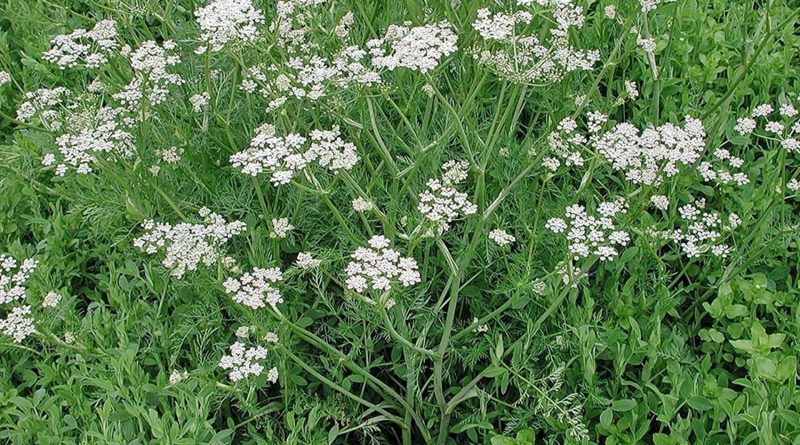Carum carvi
Carum carvi
Caraway (Carum carvi L., 1753), also known as comino or carvi, is a biennial plant belonging to the Apiaceae family, which must not be confused with cumin (cuminum cyminum), which has similar fruits but with an aroma completely different.
Systematics –
From the systematic point of view it belongs to the Domain Eukaryota, Kingdom Plantae, Subarign Tracheobionta, Superdivisione Spermatophyta, Division Magnoliophyta, Class Magnoliopsida, Sottoclasse Rosidae, Order Apiales, Family Apiaceae and then to the Genus Carum and to the Species C. carvi.
Etymology –
The etymology of this plant is controversial. According to some authors, it comes from κάρον káron, the Greek name of Carum carvi in Dioscorides; for others from the Greek κάρυον káryon, each fruit with a hard, woody shell; according to Pliny it would derive from the country of origin, in Asia Minor, Κᾱρία Karίa in Greek and Caria in Latin carvi: (Carum) from the Arabic Karwija in Latin Caria, ancient region of Asia Minor in southwestern Turkey: originally from Caria. The Carvi is also known by the name of Cumin or Kummel.
Geographic Distribution and Habitat –
It is a Eurasian species in the broad sense, which reappears also in North Africa. It grows wild in uncultivated grasslands, in meadows in the mountains, along roadsides and in rural ditches all over Europe.
Description –
The plant, apparently, is similar to the carrot; it has finely divided leaves like feathers, which grow on branches of about 20-30 centimeters. The stem of the plant reaches a height of 40-60 cm and casts white or pink flowers. The fruits of Carum carvi as those of other species of Umbelliferae are wrongly called seeds, have a semicircular shape and are about two millimeters long.
Cultivation –
Caraway is widely cultivated in Germany, Holland, Poland, Spain and North Africa and is harvested before the seeds are completely ripe, since at that time the maximum content of essential oil is obtained. The plant requires warm climate, sunny location and well-drained soils. It grows between 800 and 2200 m s.l.m ..
Uses and Traditions –
From the Middle Ages, therefore, Carvi was known and used in medicine as carminative and digestive and in the kitchen as a flavoring. In fact, the fruits of the carvi are one of the most reliable and powerful carminatives (for the mechanism of action of the carminatives see the Fennel card) with an equally important stomachic action produced by the essential oil that promotes the functionality of the stomach as a whole. The Carvi drug is made up of fruits containing 3-7% of essential oil composed largely of (+) – carvone, (+) – limonene and other terpenes. The cumin of the meadows also contains 10-18% of oil, mainly consisting of petroselinic fatty acids (30-43%), linoleic (34-37%), oleic (15-25%) and palmitic (4-5%) ; 20% of proteins; about 20% of carbohydrates; flavonoids. The main activities carried out are: stomachic, digestive, carminative, antispasmodic, galactogoga. In general, carvi is recommended in gastro-intestinal disorders characterized by spasms, flatulence, swelling. Flatulent colic in children.
Preparation Mode –
The Caraway, is a seed widely used in the kitchen for its carminative action. The use of Carvi as flavoring becomes important especially among the German populations who used and still use these seeds (also known as “Anici dei Vosgi”) as a spice to flavor bread, desserts and cheeses and to improve the digestibility of foods that can cause flatulence (in particular the cabbage). The Carvi is also one of the main ingredients in the preparation of liqueurs and brandies, known as Kummel. These are able to improve the tolerability of many foods, especially fat ones. Attention to those who show hypersensitivity to other plants of the Apiaceae family (Umbelliferae).
Guido Bissanti
Sources
– Wikipedia, the free encyclopedia.
– Treben M., 2000. Health from the Pharmacy of the Lord, Advice and experience with medicinal herbs, Ennsthaler Publisher
– Pignatti S., 1982. Flora of Italy, Edagricole, Bologna.
– Conti F., Abbate G., Alessandrini A., Blasi C. (edited by), 2005. An annotated checklist of the Italian vascular flora, Palombi Editore.
Warning: Pharmaceutical applications and alimurgical uses are indicated for informational purposes only and do not in any way represent a medical prescription; there is therefore no liability for their use for curative, aesthetic or food purposes.


